Abu Dhabi
Discovering a country more complex than its stereotypical portrayal would suggest.
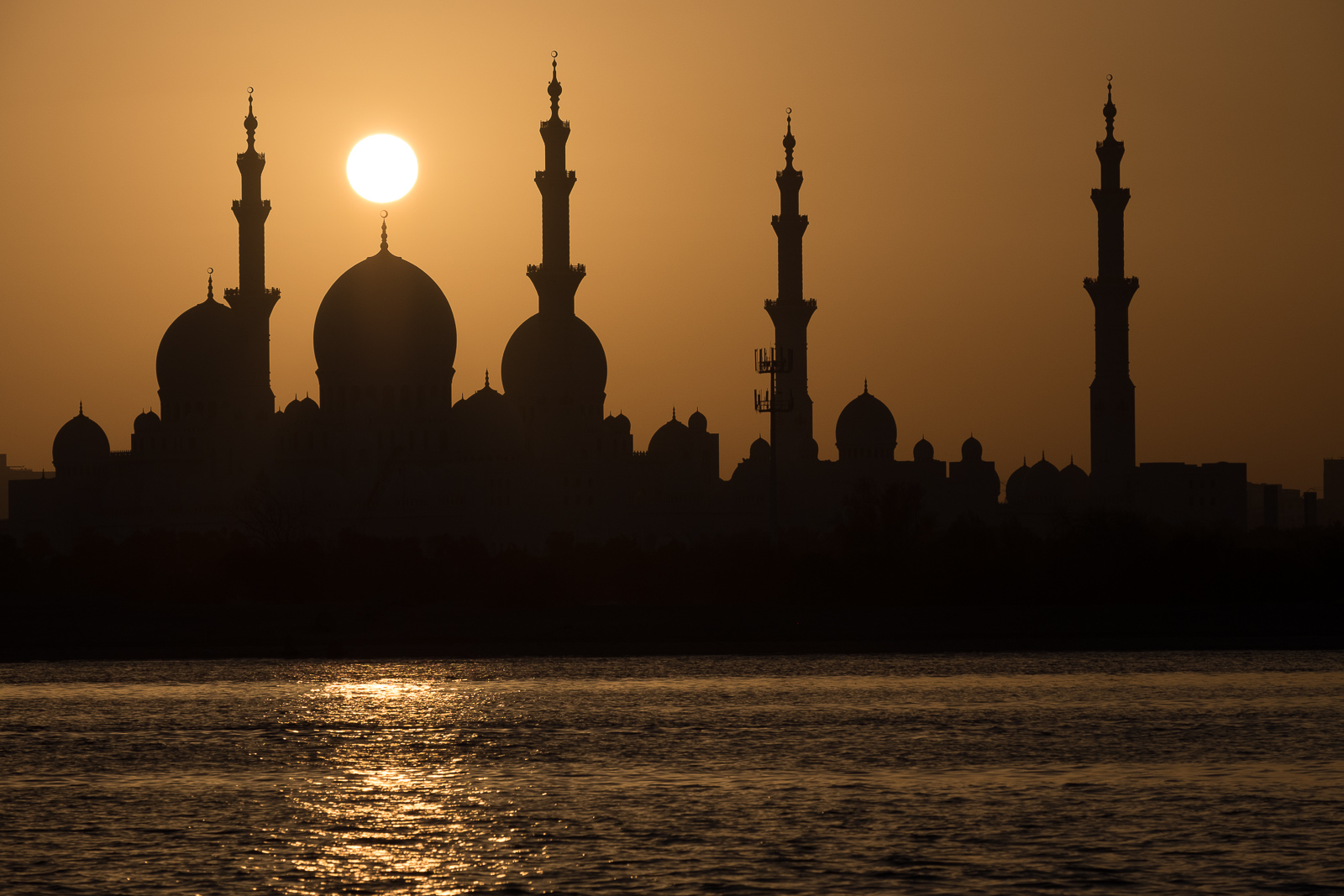
The United Arab Emirates, and in particular its two largest and most prominent cities, Abu Dhabi and Dubai, have become a byword for largesse and conspicuous consumption. The tallest buildings, the fastest cars, the most expensive clothes; more, more, more, more expensive, more palatial, more absurd. It’s become a cheap gag: “all fur coat and no knickers”, shallow, facile, tasteless.
As always, there is truth in the stereotype. But most people’s experience of the UAE, either as tourists or as longer-term visitors, is of Dubai, just one of the seven emirates. Dubai is excess on a grand scale, a party town full of ageing ex-pats who plough their tax-free salaries into alcohol and domestic help. The other emirates, though, have distinct characters, and on the whole are more reserved; perhaps the starkest contrast is with the other most prominent emirate: Abu Dhabi. It occupies the vast majority of the UAE’s territory – albeit mostly in the form of empty desert – and its eponymous capital city is the home of the UAE’s ruling family, the descendants of its revered founding father Sheikh Zayed. As a result it occupies a more privileged position than its neighbours, and stands slightly aloof from them.
One of the handful of things it does have in common with the other emirates, though – and what strikes you as soon as you arrive – is the heat. Temperatures can reach 50ºC in the long summer that seems to last from April to October; it’s commonplace for the thermometer to edge above 40º. The heat is sticky; stepping outside it surrounds you, clings to you, and doesn’t abate even in the shade. It feels somehow indirect, like the heat of an oven, enveloping you with scorching air, the occasional breeze serving only to make your being cooked feel fan-assisted. In most countries, heat this oppressive invites a languorous way of living, the culture of the siesta and the veranda. But the heat here is too extreme even for that; it can’t be escaped, it must be fought directly.
Outdoor living becomes impossible in these months and so, apart from some hardy, perma-tanned beach-goers, most people spend their time hurrying from air-conditioned apartment to air-conditioned car to, distressingly often, an air-conditioned shopping mall. It would be difficult to overstate the role that malls play in social life here. They are a place for meeting friends, a place for eating and drinking, a place for conspicuous consumption, a place for skiing and sky-diving and ice-skating. They are a place to get lost in and to spend whole days in, and people frequently do.
The influence of the mall aesthetically can be felt everywhere; all buildings seem to be built with smooth-polished corridors and bright lights, with public sculpture and atriums and unnecessary water features. It’s opulent, but it’s the generic sort of opulence favoured by newer five-star hotels and modern shiny office blocks; a peculiarly soulless kind of luxury, chosen more than anything else to be inoffensive and impressive.
The zenith of this sort of internationalist, inoffensive luxury seems to be the Emirates Palace Hotel, which occupies a prime vantage in the north-western corner of Abu Dhabi’s main island, at the end of the Corniche promenade that runs across the city’s sea-front. Approaching it from the Corniche, the hotel itself isn’t initially visible; it’s blocked at first by an almost preposterously large gate house built of orange stone, rising up 30 metres or so and topped with a white dome and a golden spire.
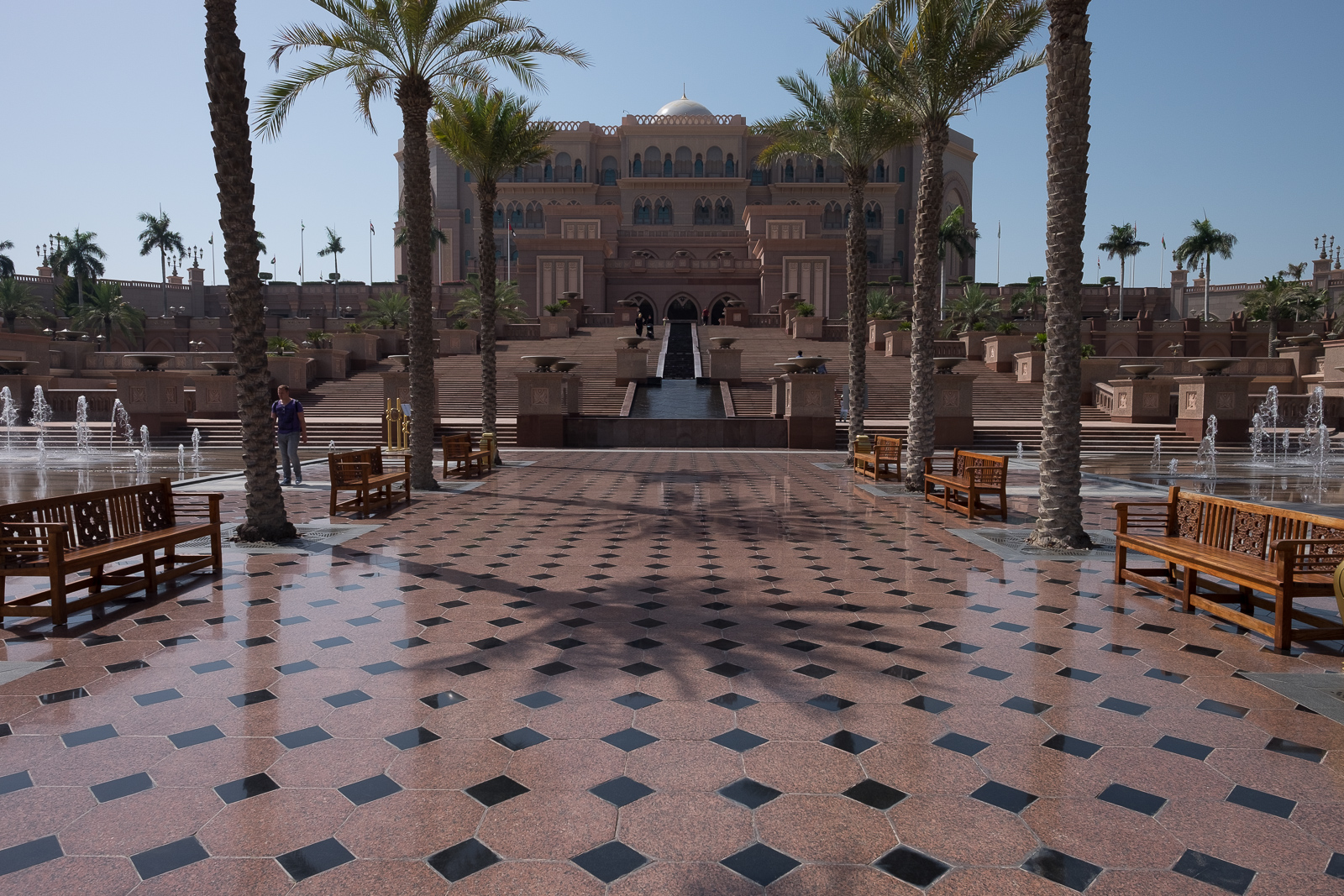
The hotel sits behind it, so large as almost to defy description, a sprawling two-winged complex with a subtly octagonal tower in the centre. For a building so ambitious and luxurious, it’s oddly unassuming; in a city full of skyscrapers, where sixty storeys are the norm, it bucks the trend by extending upwards no more than seven. Perhaps this is its own statement of superiority: skyscrapers rise up as a necessary consequence of a scarcity of land, and for that reason are somehow less opulent, more practical. The Emirates Palace, sitting on eighty-five hectares of land and with 1,300 metres of coastline to itself, has no need for height.
Its interior seems at first like a rich Arab’s idea of a rich westerner’s idea of what a rich Arab would like; the theme is gold and marble, and in quite staggering quantities. An entrance-way leads into a lobby containing a 100” TV playing closed-circuit footage of the valet parking, so that guests can watch for their cars’ arrival in the comfort of the air conditioning. The marble floor leads on past the reception to the vast expanse at the centre of the building, up from which an atrium rises six gold-tinged storeys to the dome that crowns the building; every visible surface is clad in perfectly polished marble. But it would be a mistake to think it tacky. Arches at the top of the tower rise from eight pillars; these in turn are linked by two curved squares, offset by 45° to one another, creating a doubly octagonal dome. This complex geometry, so integral to the architecture of the Islamic world, is beautiful in a deep and fundamental way; combined with the almost absurd richness of material, the overall effect is striking, and despite its scale it elevates the building beyond being a Donald Trump wet dream into something altogether finer. It’s by no means subtle, but it’s been designed with the care and attention that its clientele presumably now demand.
That such opulence exists here is a recent development and is, in any context you can imagine, utterly remarkable. In the 1950s, what is now the UAE was a desert wilderness inhabited by several disunited bedouin tribes, with an economy based on pearl hunting and piracy. Located at a crucial point in the Persian Gulf – the Strait of Hormuz, the closest point between the Arabian peninsula and Persia – the region attracted colonial attention from the early 18th century onwards, first by the Ottoman Empire in the 16th century, then by the Portuguese and finally – and most enduringly – by the British in the 19th century. Frustrated by what they saw as endemic piracy, and already in control of modern-day Oman and Yemen, the British brought the region under their control via a series of peace treaties; as a result, the sheikhdoms of the modern UAE were known as the Trucial States.
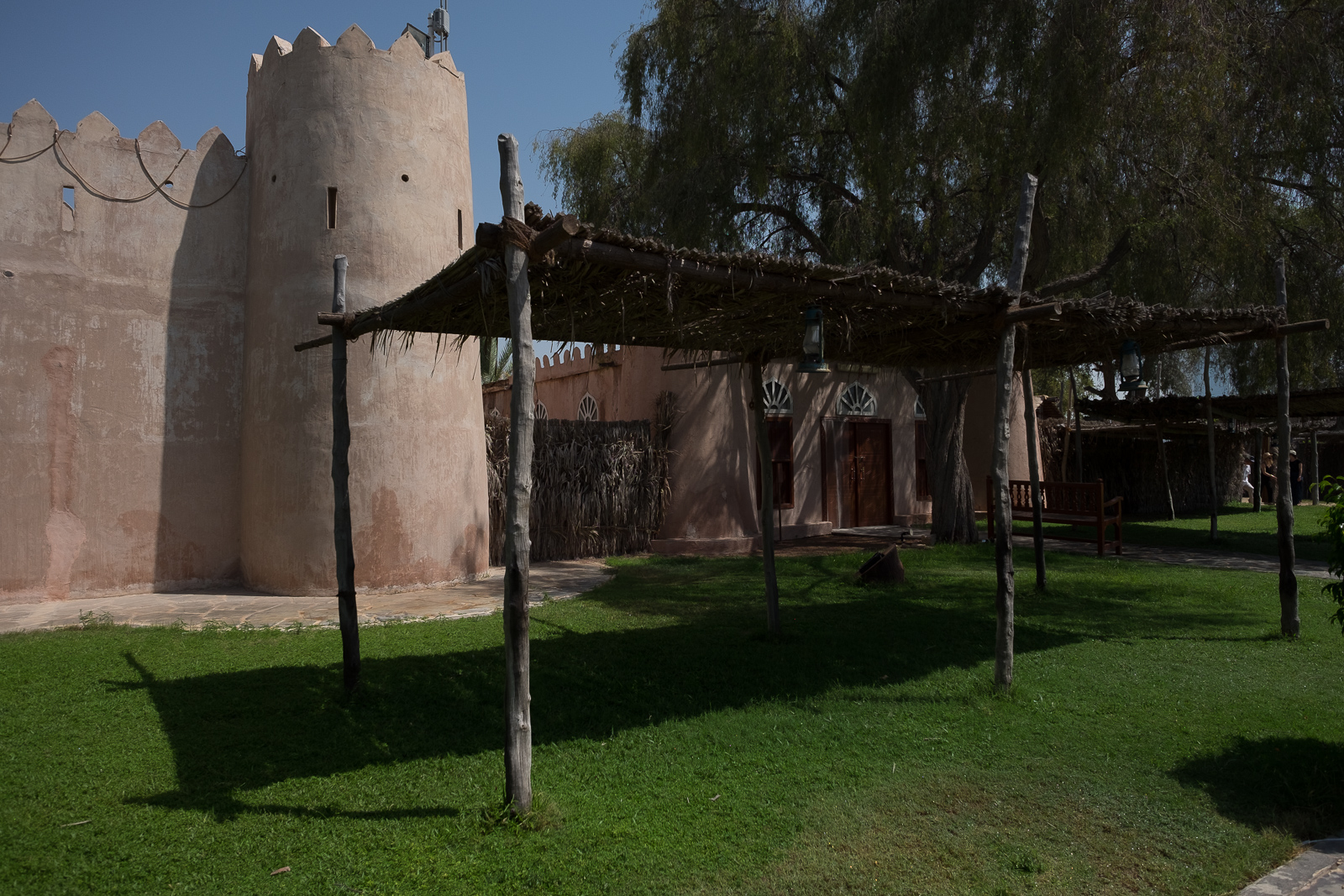
The Bedouin lifestyle is inherently nomadic, and little of permanence was built; what was has unsentimentally been destroyed to make way for symbols of the country’s bold new direction. As a result, it’s virtually impossible, wandering around the UAE today, to grasp the nature of its past. One of few places in which Emiratis attempt to make tangible this nomadic history is the ubiquitous desert safari, a tourist trip that takes in dune bashing, traditional music and dance, bedouin food, and (optionally) a night spent under canvas out in the desert. It’s almost a requirement for visitors, and I dutifully booked my place on one that took a crowd out from Abu Dhabi into the desert between it and Al Ain, Abu Dhabi’s second – and only other – city.
The first activity, while there was still daylight, is dune bashing: the adrenaline-soaked driving of 4x4s over, around, and through the desert’s colossal sand dunes. Our driver takes our ancient Land Cruiser at dizzying speed through the desert, waving his way across the crests of dunes, lurching down stomach-clenchingly steep inclines, powering his way up, sliding sideways down again, cackling aloud as he does so. One of my fellow passengers is a Portuguese ex-pat attending her fifth desert safari, who claims to love the dune bashing most of all; she whoops with every stunt the driver pulls, cheering him on to drive faster and steeper, screaming and shouting her approval.
At one point we come across another Land Cruiser, stranded atop a dune like the ark on Mount Ararat, front and back wheels in the air. After a bit of friendly teasing from our driver to the marooned one – unsurprisingly, this career attracts a fairly macho type of person – a tow rope is produced, and the front of the stranded car is attached to the front of ours. We reverse at full speed and, with a jolt, we pull the car from its promontory; it slides down the dune, a bow wave of sand in front of it, and eventually comes to a rest. The driver starts the ignition, and sets off again, ready to crest another dune.

The final leg of the journey is taken at even more terrifying pace. Sand rushes over the bonnet and windscreen, obscuring our vision; we are thrown about within the cabin, bouncing off the ceiling and windows. The car pitches and heaves, somehow managing not to roll. Between the heat and the motion I grow increasingly nauseous, hoping to hold on until the end of the journey. We come to a stop outside the camp, and I step unsteadily down from the car, but it’s no use. I rush to the back and heave, my whole chest contorting as I throw up into the sand, my head spinning. “Don’t worry,” the driver says. “This happens a lot. Napkin?”
The camp itself is a more sedate affair. Four walls enclose a compound, flanked with small alcoves. Curious tourists smoke shisha, try on traditional dress, have their hands painted with henna; the full complement of theme park activities. Outside, quad biking, camel rides and sand boarding provide an adrenaline rush for those not yet sated by the dune bashing. Suddenly, the lights go out and the background music stops; it’s time for the traditional dancing to begin.
First to appear is a belly dancer, dressed in a diaphonous red gown barely concealing a bejewelled brassiere. Rippling and flowing, punctuating the beat of the music with staccato jabs of the hips and chest, she plays the crowd as she moves around the outside of the square, carpeted dance floor. The effect is a strange mixture of the comic and the alluring; bawdy and lowbrow, one imagines it being lapped up by an audience of male nomads, starved of female contact, captivated by the obvious sexuality. At one point she brings out a gold sword and the dance becomes less about percussion than about graceful balance: resting the sword first on her head, then her arm, then – most impressively – her hip, she continues to move around the dance floor, the sword kept perfectly still in position. For her finale she returns to the theme of her opening, and brings up a man from the crowd and begins a call-and-response dance with him, she taking the lead and he gamely responding with a surprising elasticity of hip movement, much to the amusement of the crowd. Taking a bow, she leaves the stage to thunderous applause.

The next dance is entirely different. A young-looking man of about twenty years old steps out quietly, dressed in an embroidered tunic, a long flowing skirt, and white leather boots. In his hands he carries a circular box; he stands silently, and the music begins. He starts to spin, whirling round and round, his skirt rising and falling as he changes his speed, his head whipping over his shoulder to prevent dizziness. As he spins he begins producing circular boxes, from within the first, that he holds as a veil; he produces more as the dance wends on, eventually holding two in each hand and one in his mouth as he spins on and on. This dance is known as a Tanoura and originates in Egypt; it’s a folk version of the whirling dervishes of Sufism. It’s much more mournful in tone than the previous dance, and mesmerising in its intensity. At one point the lights are switched off and the dancer’s tanoura skirt lights up in garish colours; the spinning continues as he works one tanoura over the other, producing an hour glass shape. It is a singularly lonely sort of dance; after the light show, the dancer takes off his second tanoura and, still spinning, clutches it to his chest like the possession of a departed lover. It is raw with emotion, and utterly captivating; it plays less well with the crowd, who meet his final bow with muted applause. He shuffles from the stage, holding his boxes, and the lights are switched off once more.
That Abu Dhabi has come so far in so short a time is the result of one event: the extraction, beginning in the 1960s, of vast quantities of oil. The UAE sits on top of the world’s seventh-largest oil reserves, and produces over 3 million barrels of it each day. The concommitant influx of unfathomable quantities of money utterly transformed the country and in particular its ruling sheikhs, who found themselves centi-billionaires overnight.
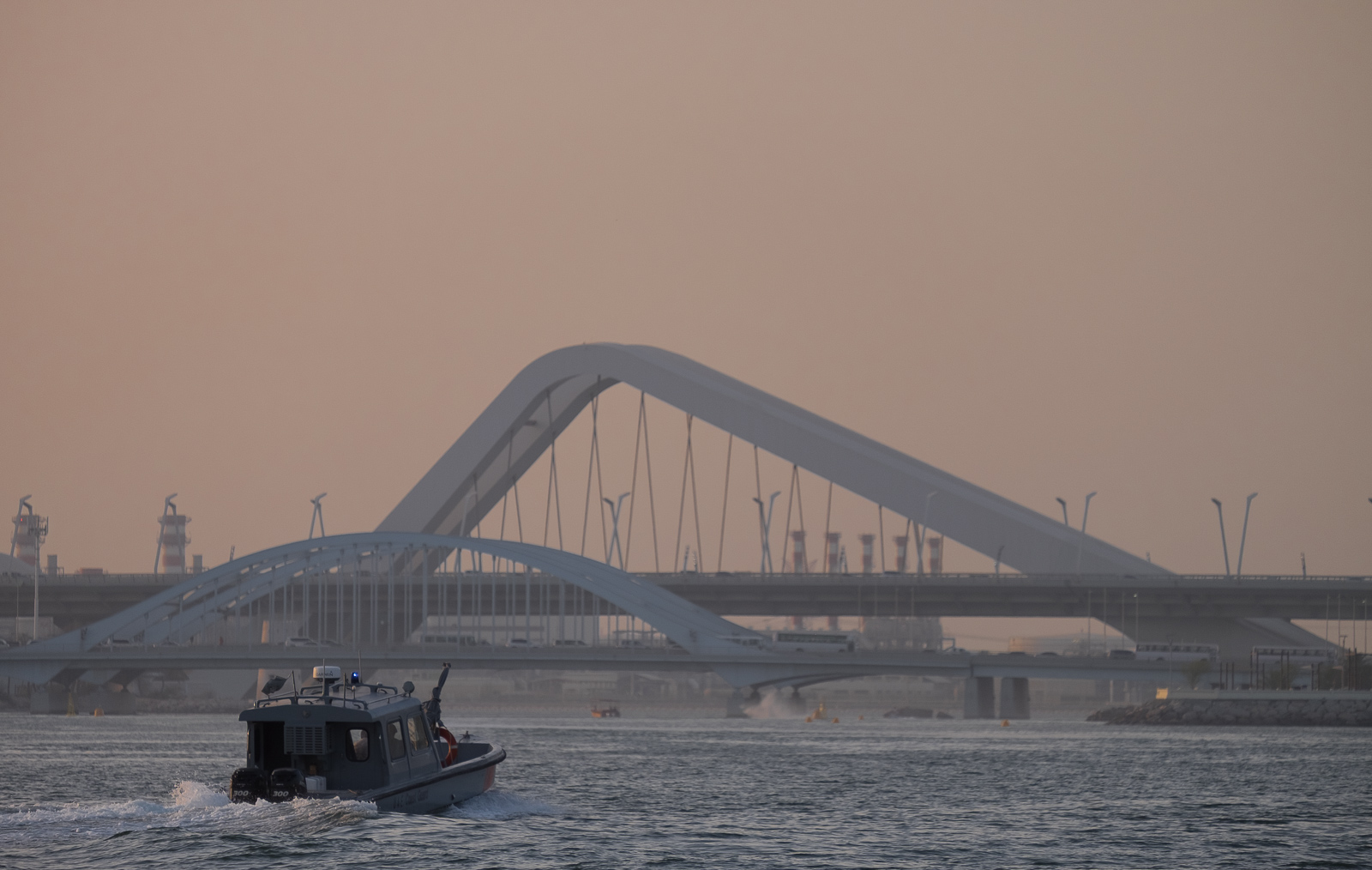
Their most sensible decision, from the perspective of their own political survival, was not to diverge from the autocratic, absolute monarchy they had ruled under for generations, and instead to stuff the mouths of their citizens with gold. The UAE is perhaps the world’s finest example of a rentier state. Its citizenry tolerate a lack of a free press, a lack of political opposition, and being governed by capricious and hereditary rulers for one stimple reason: they are virtually all stupendously well-off, and dependent entirely on the patronage of their rulers for it. Emirati citizens enjoy the pleasures of full employment, mostly in sinecure positions with enormous salaries, zero income tax, and little expectation of their doing any real work.
This pacification of the populace was paired with a genuinely far-reaching economic and infrastructural plan. Ports were built, with an eye on demand not at the time of construction but ten and twenty years into the future. Highways were carved through the desert to towns that didn’t exist yet. Whole city blocks sprang up almost overnight. Islands were reclaimed from the sea, both for superficial vanity projects like Dubai’s Palm and World (archipelagos shaped, respectively, like a palm leaf and a map of the world) and for more prosaic purposes.
To cope with this infrastructural demand, migrant workers were shipped in in their millions. Some, like those from India and Pakistan, worked on the country’s thousands of construction sites; others, from the Phillippines and Malaysia, worked in service jobs; more still, from Europe and America, supervised the construction of an entire oil industry and, later, the creation of a modern service economy.
One of the results of this mass migration is a society highly attuned to ethnic difference, in which all groups are ranked in a definite and clearly understood hierarchy. At the top are the Emiratis; below them the white-collar (and white-skinned) expatriate workers from countries like the US, Canada, and the UK; below them other expatriates; below them other Arabs; then below them a morass of migrant workers, at the bottom of which are, very clearly, Indians, Pakistanis, and Africans. This open racism permeates every aspect of society, from social interactions to job prospects to the amount people in the same jobs are paid. It’s formalised and bureaucratised, and perhaps the most openly racist country I’ve ever visited.
The upside of this diversity, though, is the wealth of nationalities and cultures to be found – away from the gleaming glass skyscrapers, anyway. The selfish traveller can find a wealth of cuisines, and particularly fine are the city’s Indian, Pakistani, and Ethiopian restaurants, which provide superb food at bargain prices.
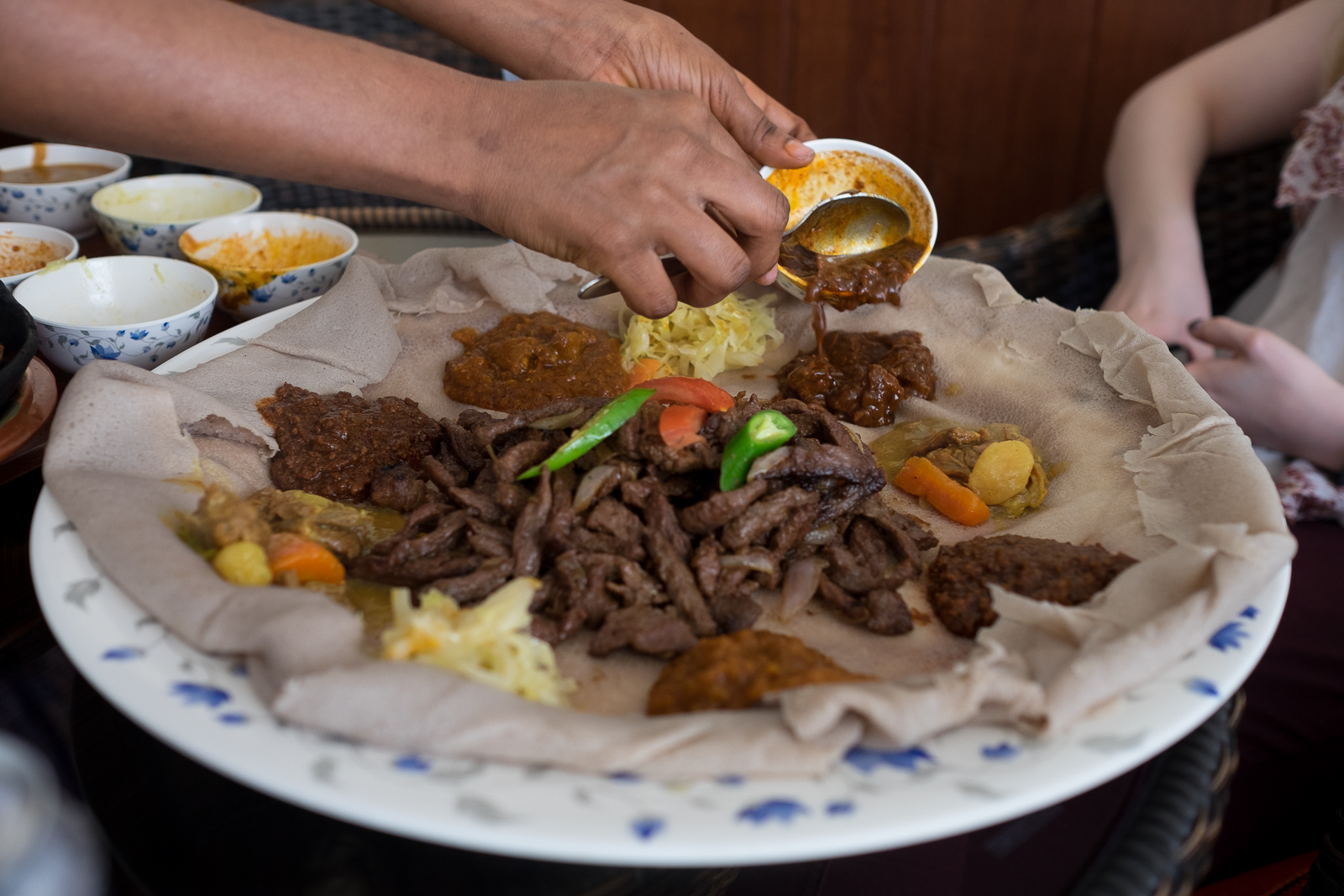
One such restaurant is the unassuming Bonne Anne, in the Tourist Club district. Located on the ground floor of an apartment building, and surrounded by Indian, Pakistani, and Chinese restaurants and shops, it serves up Ethiopian food to an audience mainly of fellow Ethiopians. The main attraction are the dishes served on injera, giant sourdough flatbreads. These breads, made from the flour of teff grass, serve as both an edible platter and a utensil for various wats or stews, scooped into piles on the bread’s surface. We tear away thick strips of the bread and use them to scoop up the stew, and then finally we eat the platter bread itself; the meal is finished when all the bread is gone. The stews themselves are a glorious variety of lamb, beef, lentils and chicken, cooked long and slow, some spicy, some mild; we also eat tibs, stir-fried, quick-cooked beef in a sticky marinade. It’s hearty, glorious peasant food that sticks to the ribs and satisfies completely.
Approaching Abu Dhabi from the airport, the first building of note that arrives into view is undoubtedly the city’s grandest and most beautiful. Four minarets frame a handful of domes, gleaming brilliant-white in the blazing sun; this is the Sheikh Zayed Grand Mosque, named for the founding father of the UAE, Sheikh Zayed bin Sultan Al Nahyan.
Zayed was, more than any other individual, responsible for orchestrating the UAE’s rapid and successful rise. In 1968, when the Labour government in Britain, pulling out from the country’s colonies around the world, made it clear that they were no longer willing to protect the trucial states, it was Zayed that took the initiative. He worked with the ruler of Dubai, Sheikh Rashid, to create a federation made up of the former trucial states; six of the seven joined at the founding in 1971, with Ras al-Khaimah following the next year. Zayed was elected President, a position he held until his death 33 years later in 2004, by which time the UAE had been transformed completely.
As a result, virtually everything significant in Abu Dhabi is named after Zayed. There are a bewildering array of roads that bear his name, sometimes in variations (“Sheikh Zayed Road”, “Zayed bin Sultan Al Nahyan Road”, and so on) but sometimes identical. There is the modern, swooping Sheikh Zayed Bridge, designed by the late Zaha Hadid. But surely the most impressive structure is the Grand Mosque.
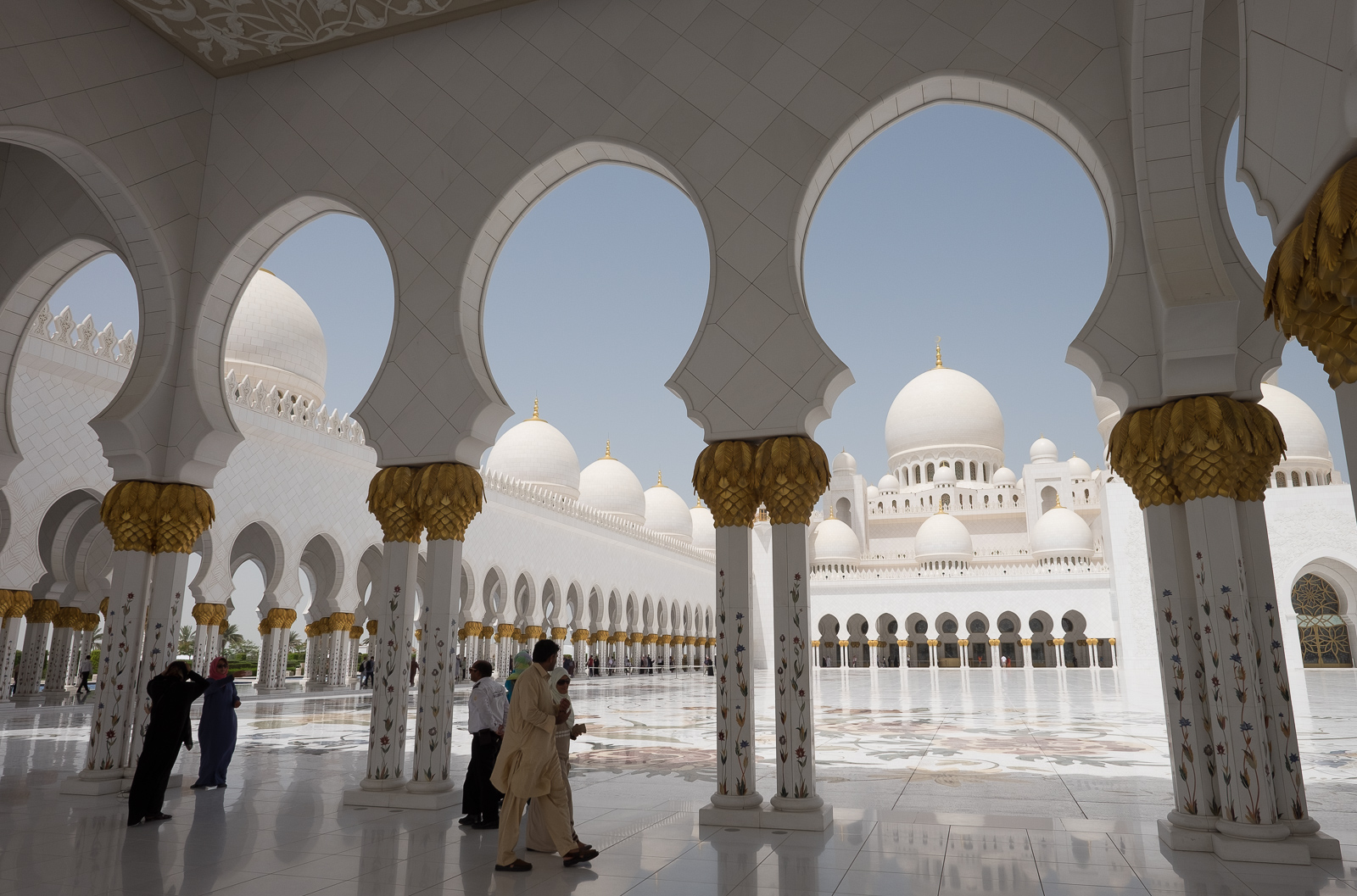
The mosque’s scale is vast. Approaching it from the east – it faces slightly south-west, in the direction of the qibla towards Mecca – three domed arches penetrate an enormous façade covered with a fantastically elaborate floral illustration in carved relief. Walking through the middle archway and into the entrance hall, you get a glimpse of the main courtyard and, across its polished and reflective surface, the musalla or prayer hall. Crowned with a huge dome, it’s framed perfectly by the archway, which mirrors the dome’s shape and focusses the eye on it. The prayer hall itself is reached by walking around the cloistered sides of the mosque, the arch of each providing a new framing of the mosque’s domes and minarets. Everything is cut from the same perfectly white stone, which positively blazes in the sunlight; the simplicity and scale of the architecture is beautiful.
Removing my shoes and stepping inside the blissfully air-conditioned prayer hall, the aesthetics change. Simple white is replaced with gilt; every surface is covered with ornate carvings and illustration. From the top of each of the three domes drop enormous glass chandeliers, radiant in blue, green, and gold, reaching up some thirty metres to the tops of the domes. Everything is filligree; no surface is left untouched. It’s beautiful, in its way, but it’s too much; it undermines the bold simplicity of the exterior. And yet it somehow seems right, in the context of the wider city. Could it really be Abu Dhabi’s grand mosque without a little excess, without being sprinkled with some gold?
Abu Dhabi is a country and a city of difficult contradictions. It’s impossible not to notice the racism and sexism that are universal in society. It’s impossible not to notice the treatment of migrant workers, who toil in 50º heat six days of the week and live crammed into dormitories in labour camps. But equally it’s impossible not to be impressed by the way its rulers have funneled oil wealth into breakneck progression, especially when you compare its progress to countries like Nigeria, where the profits of the oil industry have been skimmed off by a handful of the military dictatorship’s cronies and where the vast majority of the gulf region’s population remain in the poverty they experienced before oil was struck.
It’s naïve to imagine that now that the country has “caught up” with the most developed in the world there will somehow be an impetus to liberalise, for the ruling sheikhs to relax their grip on power, for social development to catch up with economic. There’s no reason for that to happen. It comes as a challenge to a liberal observer, though, to witness the thoroughness with which those who live here seem not to care. Economic development simply matters more to people, and it’s impossible to deny that the lifestyles of Emiratis – and of the majority of ex-pats – are immeasurably better than before, even if that has come at a great human cost.
I visited with a laundry list of preconceptions about the region and the country; I was prepared, in all honesty, to hate it. But reality, as ever, is more complex than reductive viewpoints allow. People are not their governments, or their governments’ policies; there is more variance within groups than between them. More than anything, though, I realised that there is much more to the place than gold leaf and marble, and that it rewards handsomely those curious enough to visit.